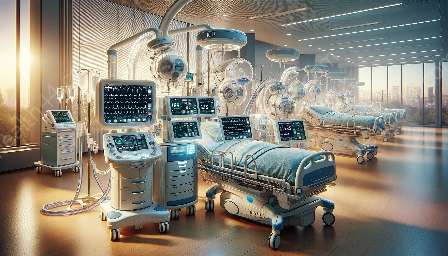Mechanical ventilators, also known as respirators or breathing machines, are crucial life support systems widely used in healthcare settings to assist patients in breathing when they are unable to do so on their own. These medical devices and equipment play a crucial role in critical care, providing essential respiratory support for patients with various medical conditions, including respiratory failure, trauma, or other life-threatening illnesses.
Understanding mechanical ventilators and their compatibility with life support systems and other medical devices is essential for healthcare professionals and patients alike. From their technological intricacies to their life-saving functions, this comprehensive topic cluster aims to shed light on the significance and real-world applications of mechanical ventilators in the realm of medical care.
The Technology Behind Mechanical Ventilators
Mechanical ventilators are sophisticated medical devices designed to deliver controlled amounts of oxygen and air to the lungs while removing carbon dioxide from the body. These devices consist of a range of components, including a ventilator interface, tubing, air filters, sensors, and a control system. The ventilator interface, typically a breathing tube or mask, connects the patient to the ventilator, allowing the delivery of respiratory gases directly into the airways.
The control system of a mechanical ventilator is equipped with advanced technology, including microprocessors and sensors, to regulate parameters such as tidal volume, respiratory rate, and inspiratory airflow. This precise control enables tailored respiratory support according to the patient's specific needs, ensuring optimal oxygenation and ventilation.
Functions and Significance of Mechanical Ventilators
Mechanical ventilators are instrumental in providing life support to patients who are unable to breathe adequately on their own due to respiratory failure, neuromuscular disorders, or critical illness. These devices assist in maintaining proper oxygen levels in the blood and expelling carbon dioxide, supporting patients' respiratory function and promoting recovery.
Beyond respiratory support, mechanical ventilators offer crucial ventilation strategies, including positive pressure ventilation, which aids in overcoming lung compliance and resistance issues. Additionally, specialized modes of ventilation, such as pressure support ventilation and synchronized intermittent mandatory ventilation, cater to individual patient needs, enhancing comfort and minimizing the risk of ventilator-associated complications.
Lifeline of Critical Care: Integration with Life Support Systems
The seamless integration of mechanical ventilators with comprehensive life support systems is essential for delivering holistic critical care to patients in intensive care units and emergency settings. Ventilators are often part of a larger network of life support devices, including cardiac monitors, infusion pumps, and hemodynamic monitoring systems, forming a cohesive ecosystem to monitor and sustain vital physiological functions in acutely ill patients.
Moreover, advancements in medical technology have led to the development of sophisticated ventilator systems with integrated alarms, remote monitoring capabilities, and interoperability with electronic medical records. This integration ensures prompt detection of changes in the patient's respiratory status and enables healthcare professionals to make timely interventions, optimizing patient outcomes and safety.
Impact of Mechanical Ventilators on Patient Care and Outcomes
As a cornerstone of critical care, mechanical ventilators significantly impact patient care and outcomes, particularly in managing acute respiratory failure, post-operative recovery, and severe lung conditions. The precise control and customization of ventilation parameters contribute to reducing the risk of ventilator-induced lung injury and airway complications, enhancing patient comfort and minimizing the duration of mechanical ventilation.
Additionally, the use of advanced ventilator modes, such as lung-protective ventilation and extracorporeal membrane oxygenation (ECMO), has revolutionized the management of acute respiratory distress syndrome (ARDS) and refractory hypoxemia, showcasing the pivotal role of mechanical ventilators in saving lives and promoting recovery in critically ill patients.
Future Trends and Innovations in Mechanical Ventilation
The field of mechanical ventilation continues to evolve with ongoing research and technological innovations. Emerging trends include the integration of artificial intelligence and machine learning algorithms in ventilator control systems, enabling personalized ventilation strategies based on real-time patient data and predictive analytics.
Furthermore, advancements in portable and wearable ventilator technologies are expanding the possibilities for home-based respiratory support, empowering patients with chronic respiratory conditions to lead fulfilling lives while receiving essential ventilatory assistance.
Conclusion
Mechanical ventilators represent a pinnacle of medical devices and equipment, serving as the lifeline of critical care and playing a transformative role in sustaining the respiratory function of critically ill patients. Their compatibility with life support systems and integration with evolving medical technologies underscore their indispensable nature in modern healthcare.
This topic cluster has provided a compelling exploration of mechanical ventilators, encompassing their technological underpinnings, functions, significance in critical care, and future directions. By delving into the intricacies of mechanical ventilators, healthcare professionals and individuals gain valuable insights to appreciate their impact on patient care and the ongoing quest for innovation in respiratory support.


